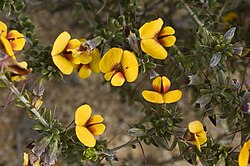Biology:Mirbelia multicaulis
| Mirbelia multicaulis | |
|---|---|

| |
| Near Lake King | |
| Scientific classification | |
| Kingdom: | Plantae |
| Clade: | Tracheophytes |
| Clade: | Angiosperms |
| Clade: | Eudicots |
| Clade: | Rosids |
| Order: | Fabales |
| Family: | Fabaceae |
| Subfamily: | Faboideae |
| Genus: | Mirbelia |
| Species: | M. multicaulis
|
| Binomial name | |
| Mirbelia multicaulis (Turcz.) Benth.[1]
| |
Mirbelia multicaulis is a species of flowering plant in the family Fabaceae and is endemic to the south-west of Western Australia. It is an erect, rigid shrub that typically grows to a height of 15–50 cm (5.9–19.7 in) and has erect stems with few branches. It has scattered, egg-shaped to oblong leaves 4–6 mm (0.16–0.24 in) long and spines that are longer than the leaves. The flowers are arranged in clusters in leaf axils or at the base of the spines and are yellow or orange and reddish-brown and appear in September and October.[2][3] It was first formally described in 1853 by Nikolai Turczaninow who gave it the name Dichosema multicaule in the Bulletin de la Société Impériale des Naturalistes de Moscou.[4][5] In 1864, George Bentham changed the name to Mirbelia multicaulis in Flora Australiensis.[6] The specific epithet (multicaulis) means "many stems".[7]
This mirbelia grows on sandy soils on sandplains in the Avon Wheatbelt, Coolgardie, Esperance Plains, Jarrah Forest and Mallee bioregions of Western Australia, and is listed as "not threatened" by the Government of Western Australia Department of Biodiversity, Conservation and Attractions.[2]
References
- ↑ "Mirbelia multicaulis". Australian Plant Census. https://biodiversity.org.au/nsl/services/apc-format/display/97156.
- ↑ 2.0 2.1 "Mirbelia multicaulis". FloraBase. Western Australian Government Department of Parks and Wildlife. https://florabase.dpaw.wa.gov.au/browse/profile/4095.
- ↑ Bentham, George; von Mueller, Ferdinand (1864). Flora Australiensis. London: Lovell Reeve & Co.. p. 37. https://www.biodiversitylibrary.org/page/26122797#page/51/mode/1up. Retrieved 9 July 2022.
- ↑ Turczaninow, Nikolai (1853). "Papilionaceae. Podalyrieae et Loteae Australasicae Non-Nullae, Hucusque non Descriptae.". Bulletin de la Société Impériale des Naturalistes de Moscou 26 (1): 283. https://www.biodiversitylibrary.org/item/107140#page/289/mode/1up. Retrieved 9 July 2022.
- ↑ "Dichosema multicaule". APNI. https://id.biodiversity.org.au/instance/apni/529874.
- ↑ "Mirbelia multicaulis". APNI. https://id.biodiversity.org.au/instance/apni/522156.
- ↑ Sharr, Francis Aubi; George, Alex (2019). Western Australian Plant Names and Their Meanings (3rd ed.). Kardinya, WA: Four Gables Press. p. 256. ISBN 9780958034180.
Wikidata ☰ Q15535250 entry
 |

